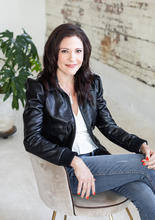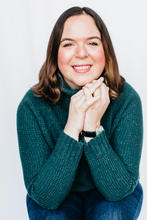How three alums took their storytelling skills and made the switch from journalism to strategic communication.
Hubbard School majors across generations have likely all asked themselves the same question: Should I focus on journalism or ad/PR? The two paths can feel very different, and over the years, these industries have definitely evolved to include new media, themes, and technologies. But one thing has stayed the same: a commitment to excellent storytelling.
Three alumni across three decades—Tim Gihring (B.A. ’95), Nicole Garrison (B.A. ’02), and Loryn Caldie (B.A. ’11)—have successfully worked on both “sides” of the industry. All three of these alumni (and countless more) have walked the line between journalism and strategic communication with prowess, equipped by their versatile Hubbard School degrees.
Ad Club, Art, and Engaging Audiences
Tim Gihring currently works as the brand narrator at the Minneapolis Institute of Art. His resume exemplifies innovation and adaptability with experiences ranging from breaking news to podcasting at organizations as varied as the Associated Press (AP) to the Tapestry Folk Dance Center in South Minneapolis.
Gihring’s journey at the Hubbard School began as a journalism major who “used too many adjectives and adverbs” in his journalism skills courses. When he saw a poster for Ad Club, he jumped in headfirst and spent the rest of his time at the School developing his creative skills and passions in the advertising realm.
“Most of my career has been that journey: How do I balance nonfiction writing with the more creative side of it?” Gihring said.
Gihring started his career by plunging into the journalism world as a news clerk at the Associated Press (AP). “At the AP, the managing editor had a board outside of her office where she honored the best lede written by someone in the bureau that day,” Gihring said. “I made it my goal to get on the board as often as I could. That was always the fun part for me—how creative and engaging can I be? That thread has carried me through.”
After spending two years breaking news at the AP, Gihring backpacked through Europe and realized his interests were growing in longer form journalism and storytelling. “Breaking news was fine, but my interests were in engaging leads, telling bigger stories, and connecting the dots,” Gihring said.
He decided to see if magazines would be the place to do that, so he joined Minnesota Monthly magazine where he spent 10 years writing feature stories and articles that “kept getting bigger”—as long as 5,000 words!—as his abilities and interests grew. “Early on at Minnesota Monthly, my editor said, ‘you’re not a journalist or writer, you're a storyteller,’” Gihring said. “That has informed the bigger view of what I do. It’s allowed me to go from one part of this world to another.”
Gihring moved from Minnesota Monthly to the Minneapolis Institute of Art (Mia) 10 years ago. He works as Mia’s brand narrator, which is closely related to content journalism, brand storytelling, and brand marketing, with the same foundation Gihring built on during his time at newspapers and magazines: Storytelling.
“Storytelling is a buzzword in our industry,” Gihring said, “but done well it has real value. Stories are how we relate to each other, how we learn, and how we engage each other. That form of communication, storytelling, is what I’ve taken from one part of the industry to another.”
Gihring spends his days looking at the museum’s collections and working with curators on exhibitions to find engaging stories to tell across mediums, including blogs and podcasts. “I’m not an art historian or an expert, but what I can do is tell stories and I can write,” Gihring said. “Behind every work of art there’s someone who made this, often for the same reasons that motivate people in so much of life: Love, power, money, greed. Everything in a museum is out of context in some way, and I try to supply that context as best I can.”
When asked about the relationship between journalism and strategic communication, Gihring notes the symbiosis between them: The “big picture” of thinking about engaging audiences.
“The idea of storytelling has been adopted by agencies and organizations, and for some that might feel like co-opting the journalism world, but for me that’s exciting, and a natural way to engage audiences,” Gihring said. “Storytelling is a very human way of relating to people, and an authentic way to share true stories behind the organization or brand.
“There used to be this strict line between journalism and PR/advertising, but people like me are beginning to find seams where skills translate into engaging audiences wherever they are. Those lines are blurring. I think they’ll continue to blur,” Gihring said.
Blurred lines, Banking, and Brand Marketing
Nicole Garrison is the senior director of employer brand and workplace marketing at the Royal Bank of Canada. Beginning during her time in Murphy Hall, Garrison has worked across journalism, public relations, marketing, and advertising. She credits her versatile Hubbard degree, and a healthy amount of persistence and resilience, as key reasons she’s been able to seamlessly move between industries.
Garrison knew she wanted to be a writer of some sort in fourth grade. She came to the Hubbard School to pursue a journalism degree, and took courses ranging from Arts Reporting and Reviewing at the Jungle Theater in Minneapolis to Media Law with Jane Kirtley–a course that prepared her to understand reputational risk and to thrive in her roles in the PR sector.
Persistence paid off in landing her first internship at her hometown newspaper, and perseverance carried her through. After completing an internship at the St. Paul Pioneer Press, Garrison launched her career at the Minneapolis/St. Paul Business Journal where she initially covered marketing, advertising, and PR. When Garrison’s editor asked her to take on banking and finance, she was certain she would fail because she was “bad at math.” Ironically, this beat is the one that ended up setting the trajectory for a majority of her career to date.
Garrison continued expanding her skill set back at the Pioneer Press in 2006 where she helped cover the housing market crash and recession. There were approximately 175 journalists in the Pioneer Press newsroom—with 21 at the business desk—when she first walked into the newsroom back in 2001. By the time she left in 2009, there were only 7 reporters left at the business desk.
Garrison pivoted to a communications director role at the Minnesota Department of Commerce in 2009 before moving on to a senior leadership position with U.S. Bank. Garrison noted that “trouble seemed to follow her” as her time in corporate public relations at U.S. Bank overlapped with the height of the Occupy Wall Street movement. She utilized connections and partnerships with senior leaders and lessons learned about reputational management at the School to help U.S. Bank stand out as a good player in the banking industry during a tumultuous time.
Garrison looks back on the various challenges she’s faced throughout her career as opportunities to build her confidence and expand her skill set.
Garrison accepted a role at Royal Bank of Canada (RBC) in 2014, where she currently serves as the senior director of employer brand and workplace marketing. In her role with RBC, Garrison brings her journalistic skills with her to work every day to write, edit, and produce content for internal and external audiences.
“One of the hardest things I’ve ever done was to give up my career as a journalist,” Garrison said. “I remember talking to some of my newsroom friends, crying, and saying: ‘I’ll never love a career as much as I love this one.’ But that wasn't true. My role now is a perfect combination of journalism, strategic communication, advertising, and marketing. It’s an exciting field, and I’m having as much fun if not more than that now.”
In her current role at RBC, Garrison led the team that built RBC’s very first employer brand from scratch. She spends a majority of her time telling RBC’s story through long form content, sponsored content, strategic communication, advertising, and creative imagery.
“This whole notion that you need a separate brand to attract and retain talent is fairly new. But the discipline is about more than pretty ads, it’s rooted in storytelling, just like my journalism degree is,” Garrison said. “In employer branding, we seek to make an emotional connection with current and prospective talent, to tell the company's story. It’s advertising, but it’s storytelling, too—even ads need to tell a story with a motive.”
Data, Analytics, and Campaign Management
Over the past decade, Loryn Caldie has leveraged skills gained in her Hubbard School courses to take on roles including Key Account Coordinator at iHeartMedia, Digital Campaign Manager at Minnesota Public Radio (MPR), and currently, Associate Manager of Reporting and Insights at Best Buy Ads. In her current role, Caldie “uses journalism skills to tell stories about numbers and marketing campaigns” on a daily basis.
Throughout her Hubbard School journey, Caldie found herself following her interests through five internships between 2007 and 2011: American Jewish World, a newspaper that focused on the Twin Cities’ Jewish community; City Pages; iHeartMedia/KDWB-FM; the South Washington County Bulletin; and Thomson Reuters.
“All of my internships jump-started my career experience. I wanted to do as much as possible!” Caldie said.
Caldie reflects on her Hubbard School experience as one characterized by hands-on professional journalism courses that built her confidence and skills, most notably in courses with Gayle Golden (G.G.) and Shayla Thiel-Stern. Not only did she land a freelance article with Plymouth Magazine in G.G.’s magazine writing class, she learned how to design the layout of a newspaper with Thiel-Stern.
Data, analytics, and metrics also played a central role in Caldie’s experience. Caldie counts Database Reporting as one of her favorite classes. Before taking Database Reporting, Caldie didn’t know how to use Excel. In class, though, she learned formulas and pivot tables and lookups; now she uses Excel every single day. At MPR, she used data to quantify her decisions about selling and optimizing ads for streaming and digital display. At Best Buy, she reports on the effectiveness of various ad campaigns.
“My whole job is based on how campaigns did, if they did poorly or if they did great,” Caldie said. “Learning how to read the data in general is important, but especially paying attention to ad attributed revenue. My job is retention, so learning how to read and use data to prove a story or prove a point is important as it helps provide revenue for the company. My whole job hinges on it.”
When asked about the transition from professional journalism to marketing, Caldie said it was natural as she “followed her interests” and “wasn’t afraid to try other things.” Caldie looks forward to continuing to learn more and lean into skills in operations, specifically around perfecting processes.
Caldie, Garrison, and Gihring have been surprised at the twists and turns their careers have taken, as they couldn’t predict when they graduated they’d be where they are today, and all of them insist that writing, storytelling, and working well with others are foundational skills and principles they learned at the Hubbard School that still pay dividends for them on the job today.
“At the end of the day, you need to know how to tell a good story that connects with your audience,” Garrison said. “This is true in journalism, PR, advertising, and marketing. That is why my time at the Hubbard School was so great. That’s one of the things I learned early on that has enabled me to bounce within all of these disciplines.”
By Allison J. Steinke (Ph.D '22)


